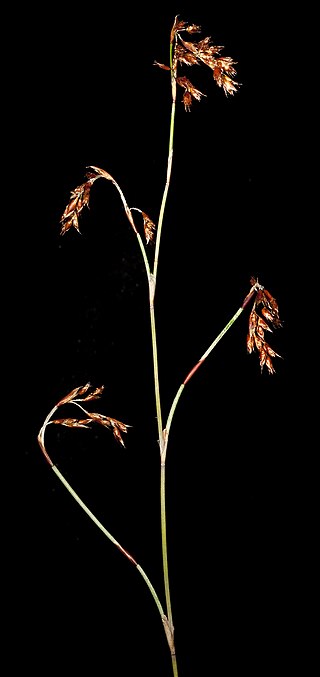Micrococca is a plant genus of the family Euphorbiaceae, first described in 1849. It is native to tropical Africa, Madagascar and Asia.

Cotula is a genus of flowering plant in the sunflower family. It includes plants known generally as water buttons or buttonweeds.
Micrococca scariosa is a species of plant in the family Euphorbiaceae. It is found in Kenya and Tanzania.

Lepyrodia is a plant genus in the family Restionaceae, described as a genus in 1810.

Mallee Woodlands and Shrublands is one of 32 Major Vegetation Groups defined by the Australian Government Department of the Environment and Energy.

Leptinella is a genus of alpine flowering plant in the family Asteraceae, comprising 33 species, distributed in New Guinea, Australia, New Zealand, South Africa, and South America. Many of the species are endemic to New Zealand.

Oxychloris is a genus of Australian plants in the grass family. The only known species is Oxychloris scariosa.

Leptinella plumosa is a small flowering plant in the daisy family. It is a circumantarctic species found on many subantarctic islands in the Southern Ocean. The specific epithet comes from the Latin for “feathery”, referring to the form of the leaves.

Meeboldina is a plant genus in the family Restionaceae, described as a genus in 1943. It is named for the botanical collector Alfred Meebold.

Acilepis is a genus of Asian plants in the Vernonieae within the daisy family.

Iris glaucescens is a plant species in the genus Iris, it is also in the subgenus Iris. It is a rhizomatous perennial, found in Russia, Kazakhstan, Mongolia and China. It has blue-grey sickle-shaped leaves, slender stem, and spring flowers in blue-violet, pale violet, lilac-purple, to deep purple, to light bluish, and almost white shades. It is rarely cultivated as an ornamental plant in temperate regions. It was merged with another similar iris in the region, and became a synonym of Iris scariosa, before being divided into two separate species again. Although some sources still call it a synonym of Iris scariosa.

Iris scariosa is a plant species in the genus Iris, it is also in the subgenus Iris. It is a rhizomatous perennial, from the mountainsides of Russia, Kazakhstan, Mongolia and China. It has sword-like, or sickle shaped, blue green or grey-green leaves, a short flowering stem, 3 or 4 membranous or semi-transparent flower bud leaves, 2 violet, reddish violet, lilac, blue-purple, or blue flowers in late spring, with yellow or white beards. It is cultivated as an ornamental plant in temperate regions. It was merged with another similar iris in the region, and Iris glaucescens became a synonym of Iris scariosa, before being divided into two separate species again. Although some sources still call it the main species, despite a slight colour difference.

Leptinella squalida is a species of flowering plant in the daisy family, native to New Zealand. Known as "brass buttons" for its yellow button-like flowers, it grows to about 5 cm (2 in) tall, spreading indefinitely via rhizomes.

Cotula alpina, also known as the alpine cotula, is a perennial herb in the family Asteraceae. It is a small flowering plant that forms ground covering mats and is well adapted to alpine environments.

Leptinella filiformis, or slender button daisy, is a species of flowering plant in the daisy family, found only in the north-eastern part of the South Island of New Zealand. Thought to be extinct by the 1980s, it was rediscovered growing on a Hanmer Springs hotel lawn in 1998, and in the wild in 2015.

Triodia scariosa, is more commonly known as porcupine grass or spinifex, and belongs to the endemic Australian grass genusTriodia. The species is perennial and evergreen and individuals grow in mounds, called hummocks, that reach up to ~1m in height. The leaves are ~30cm long, 1mm in diameter, needlepointed and rigid, and its inflorescence is a narrow, loose panicle that forms a flowering stalk up to ~2m in height. The name is derived from latin; Triodia refers to the three-toothed lobes of the lemma, and scariosa is in reference to the thin, dry glume. The species is common to Mallee (MVG14) and Hummock grassland (MVG20) communities, in arid and semi-arid regions of Australia.

Tetraria is a genus of flowering plants in the sedge family, Cyperaceae, native to Tanzania, South Africa, Borneo, Australia and New Zealand.

Lepyrodia scariosa is a common species of grass-like plant of the family Restionaceae. It is found mainly in New South Wales in moist sand or peaty soil, growing up to 90 cm tall in heath and woodland and near the edges of swamps. The specific epithet scariosa is derived from Latin, meaning membranous or scar-like, referring to the floral bracts. This is one of the many plants first published by Robert Brown with the type known as "(J.) v.v.", which means that Brown saw it living at Port Jackson. It appears in his Prodromus Florae Novae Hollandiae et Insulae Van Diemen in 1810.

Leptinella lanata is a small flowering plant in the daisy family, native to the Antipodean Islands. Its specific epithet, lanata, describes its woolly-haired (lanate) rhizomes.

Liatris scariosa, called savanna blazing star, is a species of flowering plant in the genus Liatris, native to the US states of Maryland, North Carolina, Pennsylvania, Tennessee, Virginia and West Virginia. It is fire-adapted, and its seeds germinate if they detect chemicals from plant smoke. It is a perennial herb that grows in dry woods and clearings. The Latin specific epithet scariosa means shriveled.


















